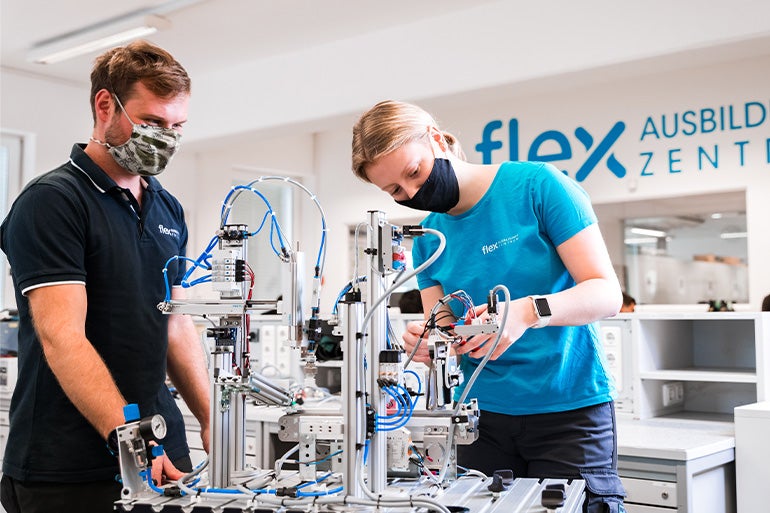
Every year in the United States, we observe Manufacturing Day on the first Friday of October. This is a day meant to celebrate our industry, share the exciting advances we’ve made, and highlight the many career opportunities available to those seeking a dynamic role in shaping the factories of the future.

Having worked in manufacturing for over two decades, I have seen the industry’s transformation over time, with Industry 4.0 (I4.0) trends like the digitization of supply chains, use of automation and robotics, and implementation of simulation changing the way we work and deliver great products to our customers.
Marking Manufacturing Day feels more relevant than ever today, with Deloitte’s 2023 manufacturing industry outlook stating that in the United States alone, manufacturing output is “surpassing expectations from the prior two years,” and “policy initiatives such as the Creating Helpful Incentives to Produce Semiconductors for America Act (CHIPS Act) and Inflation Reduction Act (IRA) have the potential to help sustain recovery in the manufacturing industry.”
Manufacturing in the past, present, and future
Many of us studied the Industrial Revolution in school, so public perception of the manufacturing industry can be stuck in the images we saw in textbooks. When we think of factories, what often comes to mind are smokestacks and assembly line workers monotonously carrying out repetitive tasks with old-fashioned industrial equipment.
In fact, today’s modern manufacturing facilities bear little resemblance to those factories of centuries or even decades ago. Many tasks and workflows are automated and optimized with advanced machinery, where data is collected and analyzed in real time from multiple sources to help managers avoid line breakdowns, address supply issues, increase productivity, and even reduce waste.
When we talk about I4.0, it refers to the Fourth Industrial Revolution — the manufacturing industry’s current stage. The First Industrial Revolution, which started around 1765, came about when coal power was used on a large scale to accelerate production. Gas power ushered in the Second Industrial Revolution around 1870, and the Third Industrial Revolution followed nearly 100 years later with the introduction of electronics and nuclear power. In 2000, the advent of the Internet and renewable energy sources ushered in the Fourth Industrial Revolution.
Advanced manufacturing delivers more opportunities
Every time our industry has faced a transformative shift, workers have feared that new technology will make them replaceable or obsolete. Though I.40 technologies like automation, robotics, and generative AI have surfaced some of the same concerns, the truth is that this new era in manufacturing needs more workers, not fewer. A 2022 article by McKinsey & Company reinforced that “the reverse is proving to be true, with Fourth Industrial Revolution technologies driving productivity and growth across manufacturing and production.”
This has certainly been the case for Flex. As I mentioned in last year’s Manufacturing Day post, people are at the center of I.40, and the new era of manufacturing will provide ample opportunities for innovators, problem solvers, and makers. We will especially need more technically skilled workers who can interpret and act on data-driven insights and have the problem-solving skills necessary to keep advanced machinery running smoothly.
Ultimately, real-time, human problem solving drives the most value and ensures that deadlines are met, quality products are manufactured, and issues are solved quickly through innovative solutions.
Video Unavailable
The content you’re seeking is momentarily unavailable. We appreciate your patience and look forward to sharing it with you soon.
On Manufacturing Day 2023, Flex celebrates the innovative people and advanced technologies driving our industry’s transformation.
Preparing the workforce of the future
The looming challenge for our industry is finding and training the right employees to meet future demand. According to a joint study by Deloitte and The Manufacturing Institute, “[the] manufacturing skills gap in the U.S. could result in 2.1 million unfilled jobs by 2030.” Upon returning from Davos 2023 earlier this year, my Flex colleague Paul Baldassari, president of Manufacturing and Services, reflected on what needs to be done to address this need at a global level. He said, “To address the skills gap, we need to collaborate across the public and private sectors to prepare workers for an increasingly digital world.”
Technical schools and colleges alone cannot be responsible for providing the number of skilled employees needed to meet our industry’s growing demand. To build and run the factories of the future — and transform our world for the better — we must proactively create opportunities for workers to develop skills and pursue fulfilling career pathways.
At Flex, with over 170,000 employees in 30 countries, we do the work by fostering a culture of collaboration, purposeful execution, and ongoing development. It is crucial that we provide our workforce with opportunities to continue learning and growing so that they can confidently work with the advanced technologies that make up the factories of the future.
For example, Flex’s Capability Acceleration Program trains employees around the world on a broad range of disciplines and skills related to I.40. Courses cover topics such as automation, simulation for future-stage modeling, extended reality (XR), and more. This program has trained more than 9,000 Flex employees in the last three years.

Around the world, we have also partnered with local schools and universities. In Althofen, Austria, Flex established an “IIoT Academy” to upskill workers. This resulted in promising improvements in overall safety and quality, along with staff trained as specialists in areas ranging from data fluency to machinery repair.
We also opened a new learning center in Jalisco, Mexico in 2022 to develop more than 2,000 employees annually in advanced manufacturing topics such as surface mount technology, critical manufacturing processes, robotic assembly, and more.
In China, we worked closely with the local government in Suzhou to provide ongoing education for factory workers. The professional skills training offered to more than 450 employees taught skills in areas that included electrical equipment installation, operations, maintenance, and logistics.
Finding a better way together
This is a deeply exciting time to work in our industry, and I am grateful to look back on my decades in manufacturing and to reflect on how far we’ve come. We must work together — combining our unique skills, perspectives, and talents — to define the next era for the manufacturing industry.
When we move forward with a mindset of collaboration, innovation, and continuous improvement, we can improve our industry and the world at large. If you are curious about advanced manufacturing and the factories of the future, I encourage you to check out our job openings today.




